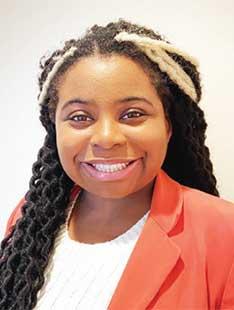The President’s Blog
Last October, I launched a blog designed to provide an informal, easy way to communicate with the Princeton community. Posts are usually brief, topical, and unbound by any publication schedule. The blog permits me to share messages that are less intrusive than a community-wide e-mail and more timely than these PAW pages, which typically have a three-week gap between submission and publication. I’ve now published more than a dozen of these short comments. You can find the blog at https://president.princeton.edu/presidents-blog. I encourage alumni to check the blog occasionally for updates.
To provide a taste of what you might find there, I reprint my most recent posting, which features an essay by rising Princeton senior Cassidy Barnes ’22. —C.L.E.
One of my highest priorities is to increase the number of low-income and middle-income students getting college degrees, both at Princeton and nationally. A college education is a rocket-booster for these tremendous young people, who for too long have been underrepresented at Old Nassau and many of our peers. We need their talent on our campus and in our country!
For that reason, Princeton strongly supports the proposed doubling of the maximum Federal Pell Grant. That program, originally created through the leadership of Senator Claiborne Pell, Class of 1940, provides crucial assistance to students from low-income families.
You can quote statistics all day long, but some of the most persuasive testimony for the importance of financial aid comes from the students whose lives it transforms. I’m accordingly delighted to publish below a posting from rising senior Cassidy Barnes, Class of 2022, a concentrator in the School of Public and International Affairs who interned this summer in Princeton’s Office of Government Affairs. I’ll bet that Senator Pell would be proud of the way that she carries forward both the spirit of his defining legislative accomplishment and his alma mater’s commitment to be “in the nation’s service.”
#DoublePell: Financial Aid Is Why I Can Attend Princeton. Students at Other Universities Aren’t as Lucky.
Seventy percent of students who drop out of college say it’s because of financial considerations. I know first-hand how financial aid can make or break going to college.
I grew up in the town of Lakewood in Washington state. My family is low income and we faced numerous financial hardships. In my school district 60 percent of students qualify for free or reduced lunch, and the median household income in my city is about $51,972, a number below the national median.
At Princeton, my full tuition, room, and board are covered through the University’s generous no-loan financial aid program, made possible by contributions from alumni with gifts both large and small. I expect to graduate from Princeton next May with a degree in Public and International Affairs and with zero debt. If you are not low income, it can be hard to really understand what it means to receive aid.

On campus, I’m a member of the Scholars Institute Fellows Program (SIFP) — a group dedicated to helping first generation and/or lower-income college students (FLI). When I asked my fellow lower-income peers what financial aid meant to them, their answers were beyond what you’d expect to hear. My roommate replied, “to me financial aid means not only the ability to go to school, but it means health insurance, it means dental and vision insurance, it means a place to live.” This sentiment was echoed by a friend who faced homelessness after ceasing to receive any financial support from her family, “Financial aid saved my life. It got me food on the table and a roof over my head.” Financial aid is life changing.
Not every school is as well funded as Princeton. For many students, it’s federal financial aid in the form of the Pell Grant that makes their college career possible. About 7 million students rely on Pell, including nearly 60 percent of Black students and nearly half of Latinx students. Sadly, the Pell has not kept up with the rising cost of tuition. With the current cap of $6,495, the Pell only covers a fraction of the costs at most colleges and universities. When Pell was created in the 1970s, it could cover around 79 percent of the cost of attendance at public four-year colleges, while today that number sits at around 29 percent.
If Congress doubled the Pell Grant maximum amount, making it so that using just the Pell would cover half the cost (and almost all the in-state tuition) of most public four-year universities in the U.S., over 80 percent of those universities would become affordable to those with Pell Grants, as compared with 25 percent now.
It’s for these reasons that I am honored to be a part of a nationwide effort this year by students and universities to increase the maximum Pell Grant amount. It’s time to lessen the burden on students and #DoublePell.











No responses yet